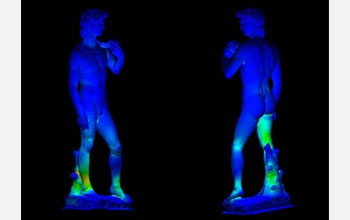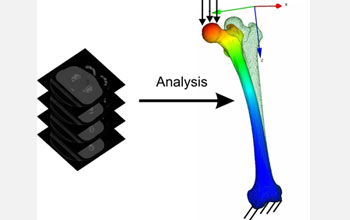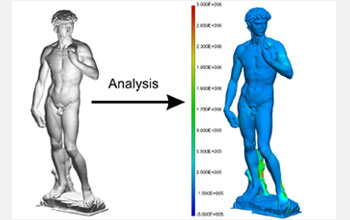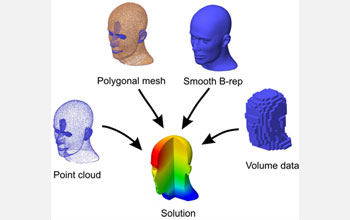All Images
News Release 08-040
Tell Them Where It Hurts
Statue of David lends perfect form to new method for modeling strain in both inanimate and human structures
This material is available primarily for archival purposes. Telephone numbers or other contact information may be out of date; please see current contact information at media contacts.

A front and back view of Michelangelo's David through the eyes of the Scan and Solve software. The red and yellow regions indicate the areas most likely to show signs of stress, and in fact, that is where small cracks have already erupted on the statue.
Credit: Members of the Spatial Automation Laboratory, University of Wisconsin-Madison
Download the high-resolution JPG version of the image. (51 KB)
Use your mouse to right-click (Mac users may need to Ctrl-click) the link above and choose the option that will save the file or target to your computer.

The researchers performed a stress analysis in a human femur directly from biomedical images (Computed Tomography (CT) scans). First, the researchers segmented the CT images, separating bone from soft tissue. Then, the researchers computed three dimensional distance information to construct a smooth, approximate distance field that describes the geometry of the bone. The mechanical properties of the bone tissue were based upon the data and existing models for bone tissue. In the final steps of the analysis, the researchers combined these and other elements to determine how the bone will deform under stress.
Credit: Members of the Spatial Automation Laboratory, University of Wisconsin-Madison
Download the high-resolution JPG version of the image. (118 KB)
Use your mouse to right-click (Mac users may need to Ctrl-click) the link above and choose the option that will save the file or target to your computer.

Researchers at the University of Wisconsin-Madison and Florida International University have developed a technique called Scan and Solve to determine points of weakness on objects, a method that is faster, simpler and easier than existing methods. Using 3-D scan data as a starting point, such as the data shown at left for Michelangelo's David, the researchers are able to identify where an object will break due to stresses like the pull of gravity. The picture on the right illustrates the von Mises stress distribution caused by gravitational forces.
Credit: Members of the Spatial Automation Laboratory, University of Wisconsin-Madison
Download the high-resolution JPG version of the image. (167 KB)
Use your mouse to right-click (Mac users may need to Ctrl-click) the link above and choose the option that will save the file or target to your computer.

The researchers conducted field modeling of objects using approximate distance fields from surface points, polygonal surfaces, smooth B-rep data and volumetric data. The simplicity of the approach is in stark contrast to the multiple representation conversions required in traditional mesh-based analysis.
Credit: Members of the Spatial Automation Laboratory, University of Wisconsin-Madison
Download the high-resolution JPG version of the image. (156 KB)
Use your mouse to right-click (Mac users may need to Ctrl-click) the link above and choose the option that will save the file or target to your computer.


